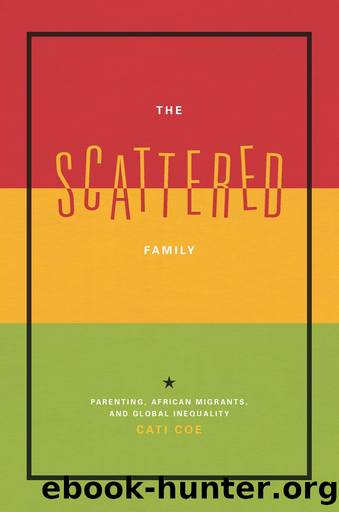The Scattered Family by Cati Coe

Author:Cati Coe [Coe, Cati]
Language: eng
Format: epub
Tags: Social Science, General, Anthropology, Cultural & Social, Black Studies (Global)
ISBN: 9780226072418
Google: bQoGAQAAQBAJ
Barnesnoble:
Goodreads: 17673966
Publisher: University of Chicago Press
Published: 2013-11-15T00:00:00+00:00
Note: Those born in Ghana, identifying as Black (N = 2,331).
Source: American Community Survey, 2006â8.
I have visited over fifty Ghanaiansâ homes on the East Coastâfrom the northern Virginia suburbs of Washington, DC, at the southern end, to Worcester, Massachusetts, at the northern end. Two-thirds of those I visited have been in New Jersey and the metropolitan area of Philadelphia and its suburbs. Outside of New York City, the majority of those whose houses I visited lived in small houses in working-class or middle-class neighborhoods in older, inner-ring suburbs. Some live in white working-class neighborhoods, particularly around Philadelphia. One gets a sense that the people in their neighborhoods, like my Ghanaian informants, are working hard to keep their heads above water and make ends meet.
Drawing on American Community Survey data from 2006 to 2008 collected annually by the US Census Bureau, Ghanaians tend to live in neighborhoods where there are an above-average number of immigrants (foreign-born) and of other Africans, but usually not in overwhelming numbers. The average census tract of the residences of forty-three interviewees whose addresses I obtained had the following characteristics: a relatively high 20 percent foreign-born population, of whom 19 percent were African born; a relatively diverse racial/ethnic composition of 40 percent white, 44 percent Black, and 15 percent Latino; a median household income (1999) of $47,833 (near the national average); a poverty rate of 12 percent (also near the national average); a four-year college completion rate of 25 percent; and a high-school completion rate of 85 percent.
However, there was also great variation in the characteristics of the neighborhoods in which respondents lived. Twelve households lived in census tracts where poverty rates were 18 percent, above the national average; seventeen households lived in census tracts with about average rates of poverty; and thirteen households lived in census tracts with low rates of poverty (less than 5 percent). Fifteen lived in areas where whites were the largest group (three in the Midwest, one in the Northeast); ten lived in census tracts in highly segregated Black neighborhoods, where Blacks were over 80 percent of the residents, with varying levels of income; eight lived in majority Black neighborhoods, three of which were Black, middle-class areas in terms of income and education; six lived in segregated white neighborhoods; and three, all in New York City, lived in majority Latino neighborhoods, with high foreign-born populations and an average high poverty rate, working-poor income, and low educational level. Overall, then, Ghanaians interviewed as part of the US portion of my study tended to live disproportionately with other immigrants, African-Americans, and other Africans, in neighborhoods with lower-middle-class household income and average education levels among its resident adults. One teenage girl living in Worcester, Massachusetts, who had recently joined her father in the United States, expressed surprise at her school and new friends: she had expected to meet whites in the United States, but instead found herself in a diverse school of Central American, South Asian, and African immigrants. In most of the interviews, it
Download
This site does not store any files on its server. We only index and link to content provided by other sites. Please contact the content providers to delete copyright contents if any and email us, we'll remove relevant links or contents immediately.
Spare by Prince Harry The Duke of Sussex(5078)
Tuesdays with Morrie by Mitch Albom(4696)
For Baby's Sake(4550)
Machine Learning at Scale with H2O by Gregory Keys | David Whiting(4200)
Never by Ken Follett(3801)
The Five People You Meet in Heaven by Mitch Albom(3476)
Fairy Tale by Stephen King(3229)
Reminders of Him: A Novel by Colleen Hoover(2952)
Will by Will Smith(2797)
Tuesdays With Morrie by Mitch Albom(2697)
The Clitoral Truth: The Secret World at Your Fingertips by Rebecca Chalker(2672)
Borders by unknow(2232)
Cruel to Be Kind by Cathy Glass(2145)
The Body Keeps the Score by Bessel van der Kolk MD(2145)
Friends, Lovers, and the Big Terrible Thing by Matthew Perry(2126)
The Stranger in the Lifeboat by Mitch Albom(2051)
Love on the Brain by Ali Hazelwood(1967)
Finding Chika by Mitch Albom(1931)
New Morning Mercies: A Daily Gospel Devotional by Paul David Tripp(1877)
